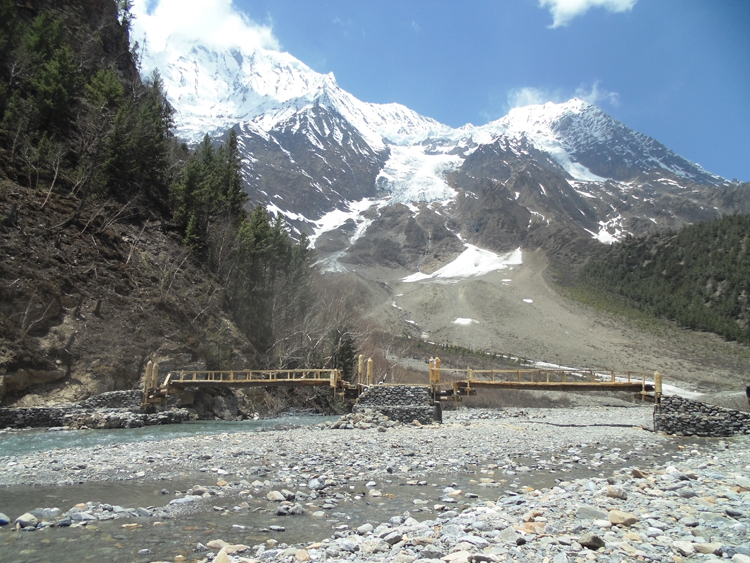Suitable tourist routes closed Dolpa
- Saturday May 27, 2023
- 0
Two years ago, there were no communication facilities in Dolpa, but now internet service has been introduced. Due to its rich biodiversity and natural beauty, Dolpa used to be a popular destination for tourists, but recently, the flow of tourists has decreased.
Dolpo-Buddha Rural Municipality has a beautiful village called Dho, a prominent place in lower Dolpo. Currently, agriculture is scarce due to the harsh climate in Dho. Only one barley crop is grown annually as the leading staple food in lower Dolpo. Due to the cold weather and limited rainfall, farming is only possible in Dho during summer. In the villages of Dho, Charkamot, Simen, Foksundo, and Kulgayat, apple farming will be initiated in the upcoming year.

Along with the seasonal waterfall, tourists from various countries visit Dolpa to witness the enchanting views of Phoksundo Lake, the ancient monasteries, and the mesmerizing Himalayas. Prem Dorje Pahuna, the manager of the Star Mountain Hotel in Dho, is busy welcoming and serving guests. He provides them with information about the tourist attractions in Dolpa.
More than two thousand people visit Dolpa to explore the scenic routes and the Shey-Phoksundo National Park. Lower Dolpa also hosts various festivals and celebrations throughout the year.
It extends up to the border of Tibet. Here, one can find various wildlife species, including snow leopards, Tibetan wolves, musk deer, blue sheep, and Himalayan wild yak. The park is home to over 200 species of birds, including the Danphe (Himalayan Monal), six reptiles, and 32 butterflies, including the famous Apollo butterfly.
The southern Himalayas, Kanjiroba South, Sikalpo Khang, and many other snow-capped peaks and pristine rivers add to the unparalleled beauty of Lower Dolpa. Similarly, the Shey Gompa, which has been imparting teachings of Tibetan Buddhism for over eleven centuries, is also located here. In light of this, it has been proposed that Shey-Phoksundo National Park be included in the UNESCO World Heritage List.
Efforts are underway to connect Upper Dolpa, including Mustang, with China through road connectivity. There are ongoing initiatives to connect Mustang in Gandaki Province and Dolpa District in Karnali Province through road networks. Similarly, under the Bheri Corridor, construction of a transboundary road connecting Nepal, India, Jumla-Surkhet, Jajarkot, Dolpa, and Tibet is underway. The road construction and improvement work from Jajarkot to Dolpa and blacktopping are also being carried out.
Establishing this road as a tourist route will contribute to the construction of the pending hydropower projects in Mid Dolpa and further enhance the excitement of tourists. With the connectivity to Lower Dolpa, local products and agricultural produce will find their way to the market more efficiently.
Best time to travel in Dolpo
The best time to trek in Dolpo is autumn and spring. The weather and visibility are ideal for trekking during these times of the year.
From September to November, autumn is considered the peak season for trekking in Dolpo. The weather during this time is stable, with dry and sunny days, making it ideal for long treks and enjoying the breathtaking landscapes.
Spring, from March to May, is another excellent time to trek in Dolpo. The weather starts to warm up, and the region becomes vibrant with blooming flowers and lush vegetation. The clear skies and moderate temperatures create a pleasant environment for trekking and capturing stunning photographs.
During these seasons, the trails in Dolpo are generally less challenging than during the monsoon season. From June to August, the monsoon brings heavy rainfall and can make the trails muddy and slippery, posing risks to trekkers.
Trekking in Dolpo during the best seasons allows you to explore the unique culture and traditions of the local communities. You can visit ancient monasteries, interact with the friendly locals, and witness their traditional festivals and rituals.
It is important to note that Dolpo is a remote region, and proper preparation is necessary before embarking on a trek. Hiring a local guide or joining a trekking group is the best way to guarantee your safety and get the most out of your hiking adventure.
In conclusion, the autumn and spring seasons offer the most favorable conditions for trekking in Dolpo, allowing you to immerse yourself in this remote Himalayan region’s natural beauty and cultural richness.
How Dolpo is different than other trekking
Dolpo stands out as a unique and distinct region for trekking, setting it apart from other trekking destinations. Here are some key factors that make Dolpo different:
Remote and Untouched Beauty: Dolpo is one of Nepal’s most remote and least-explored regions. Its isolation has helped preserve its pristine natural beauty and untouched landscapes. Unlike popular trekking regions like Everest and Annapurna, Dolpo offers a sense of solitude and tranquility amidst the stunning wilderness.
Cultural Richness: Dolpo is home to ethnic groups like the Dolpo-pa, who have their distinct language, culture, and traditions. Tibetan Buddhism profoundly influences the region; ancient monasteries and gompas dot the landscape. The unique Tibetan and Bon influences blend sets Dolpo apart from other trekking regions.
Restricted Area: Certain parts of Dolpo, such as Upper Dolpo and Shey Phoksundo National Park, fall under the restricted area category. This means trekkers need special permits to enter these regions, adding a sense of exclusivity to the experience. The restricted status helps preserve the area’s natural and cultural heritage.
Diverse Landscapes: Dolpo showcases an incredible diversity of landscapes, ranging from lush valleys to rugged mountains, barren plateaus, and pristine lakes. One of Nepal’s deepest lakes, the beautiful Phoksundo Lake, is a must-see for everyone traveling to the area. The landscapes of Dolpo are visually striking and distinct from other trekking regions.
Unique Flora and Fauna: Dolpo is renowned for its rich biodiversity. Snow leopards, Himalayan blue sheep, musk deer, and a wide variety of birds are just a few of the unique and endangered creatures that call this region home. By venturing into Dolpo, you may see these rare animals in their native environment.
Off-the-Beaten-Path Experience: Dolpo offers an unmatched sense of adventure and exploration. Trekking in Dolpo takes you through remote trails, far away from the crowds, and immerses you in the raw beauty of the Himalayas. The authentic and off-the-beaten-path experience makes Dolpo a favorite among adventure seekers.
Challenging Terrain: Dolpo trekking routes are known for their challenging terrain. The trails often involve steep ascents and descents, crossing high passes, and navigating rugged landscapes. This adds an element of thrill and adventure to the trek, attracting experienced trekkers seeking a more challenging expedition.
Dolpo, in a nutshell, is where you may experience natural beauty, cultural wealth, isolation, and adventure all at once. Its untouched landscapes, rich cultural heritage, and challenging terrain set it apart from other trekking regions, providing an exceptional and memorable experience.





